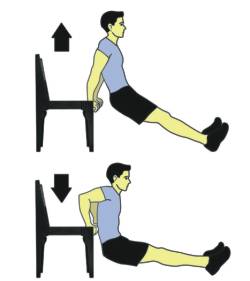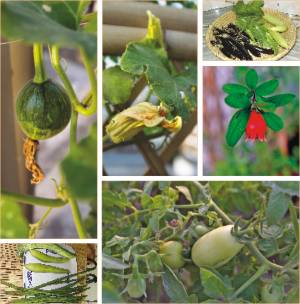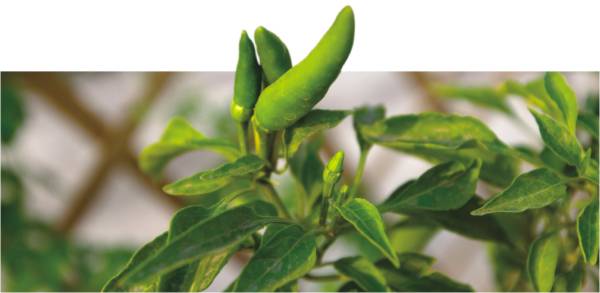SKIP THE GYM…GET FIT
Triggering Triceps Growth
By Karim Waheed
Straighten your elbow. You just used your triceps muscles, also known as triceps brachii. These muscles make up over two-thirds of the upper arm and work with the biceps muscles, which are used to bend arms.
Quick Latin lesson: triceps means “three heads”. Each of these heads (long, lateral and medial) performs a different function. When you lift something up over your head or push something away from your body or, in a very general sense, do anything that requires straight arms, you're using your triceps in a support role at the very least. The triceps counteract contraction at the elbow, which is made possible by the biceps.
 Many people training with weights make the mistake of working the biceps while overlooking the triceps. From a vanity perspective, this makes sense: big, flexed biceps look good and intimidating, while triceps are harder to show off. But I got news for you; if you want strong arms, you must balance triceps and biceps workouts. After all, triceps and biceps play an equally important role in arm movement. Many people training with weights make the mistake of working the biceps while overlooking the triceps. From a vanity perspective, this makes sense: big, flexed biceps look good and intimidating, while triceps are harder to show off. But I got news for you; if you want strong arms, you must balance triceps and biceps workouts. After all, triceps and biceps play an equally important role in arm movement.
Cardio exercises such as swimming and running work the triceps muscles without too much strain on the elbow, making them ideal workouts for anyone prone to injury, incapable of lifting weights or wanting to keep off fat without building muscle. If you place importance on building muscle for strength, aesthetics or to improve athletic prowess, you have to lift weights
Many weightlifting exercises build the triceps either as the primary or a support muscle. In general, any exercise that keeps your upper arm stationary and extends your forearms away from the core of your body will build your triceps. Here are two of my favourites:
Overhead Extensions
Hold a free weight between your right thumb and pointer finger. Cup your opposite hand under your right hand. Lift the weight so that your elbows are bent and it is behind your head.
Begin to straighten out your arms by lifting the weight up to the sky. Pause for one second, and begin lowering the free weight back to your starting position.
Exhale as you push the weight up and inhale as you lower the weight to the starting position.
Triceps Dips
Position your hands shoulder-width apart on a secured bench or stable chair. Move your bottom in front of the bench with your legs bent and feet placed about hip-width apart on the floor.
Straighten out your arms and keep a little bend in your elbows in order to always keep tension on your triceps and off your elbow joints.
Now slowly bend at your elbows and lower your upper body towards the floor until your arms are at about a 90-degree angle. Be sure to keep your back close to the bench.
Once you reach the bottom of the movement, slowly press off with your hands, and push yourself straight back up to the starting position.
FOR THE LOVE OF FOOD
1419
By Kaniska Chakraborty
Bengali New Year. Time to ring in new hope, new dreams, and new initiative. Pahela Baishakh, as the day is known, has a different dimension altogether in Dhaka. From dawn to dusk, the day is usually full of revelry, fun and festivity.
In Calcutta, it is just another holiday. We are happy if it falls on a Friday or Monday for a three-day weekend. Even a mid week holiday is most welcome.
This year, Pahela Baishakh was on a Saturday. So a holiday wasted. We decided to make the most of it nonetheless.
Energetic plans were laid down for a 'panta bhaat' (boiled rice soaked in water overnight) fest. Lot of deliberation on the accompaniment. 'Ilish mach bhaja' versus 'shutki mach' versus 'posto bora' versus 'dal' versus 'dim bhaja'. The whole animal and vegetable kingdom was discussed and nothing was decided. Typically Bangali.
I went to the market the day before Pahela Baishakh with high hopes of scoring some good ilish. Alas, the market was completely “dry”. But all was not lost. Some very fresh Mourola (whitebait) was there, showing off their silvery little bodies. I picked up a handful.
Pahela Baishakh morning, we got up to see my mother in action full tilt. She took charge of breakfast and instructed Padma di to do the dough for 'luchi' and to do 'alu bhaja'. Classic Bangali breakfast. I decided to be useful and went off to buy some sweets. Came back with a nice payload of 'langcha', 'shorbhaja', 'mihidana' and 'sitabhog'.
Ma fried 'luchi'. There was 'alu bhaja' and 'shada alur torkari'. And sweets. But the deed for the day was not done yet.
Bhaat (boiled rice) got the water treatment and was put into the fridge to soak in water and ferment a bit. The Mourola (whitebait) was crisp fried. Big starchy potatoes were boiled and mashed with fried sliced onions and roasted red chilli. We had that late in the day.
By that time, the rice was nice and soft. The water in which it was soaked had turned a little grey from all the starch seeping out and the minute amount of alcohol that was generated.
The rice got a splash of mustard oil to transform it from a benign starchy mass to this fire breathing, awe-inspiring base for the 'alu bhorta' to be mixed in.
A generous serving of ochre topped rice, with a dollop of 'alu bhorta' and a generous serving of crisp fried 'mourola'.
The sogginess of the rice, the softness of the 'alu bhorta' and the crispness of 'mourola'. Add to that the fire and brimstone of mustard oil and roasted red chillies. Chunks of eye-watering raw onion and whole green chillies completed the milieu.
Like a true Bangali, we slurped down every last drop of the panta. That was around 6 in the evening. Felt a little drowsy and hit the bed. And I slept like a baby.
Panta is such a tranquiliser. Really, wish the rest of the year could be so simple yet impactful.
Shubho noboborsho!
LOVING AND LIVING WITH PLANTS
Celebration with colours and sounds
By Laila Karim
 Baishakh has arrived -- though the 'Pahela' is gone on 14 April, we are still in the mood for celebration. Baishakh has arrived -- though the 'Pahela' is gone on 14 April, we are still in the mood for celebration.
In recent years, this celebration has become widespread, especially in urban areas crossing borders of religion, belief and class; becoming a national, 'sharbojonin uthshab' for all.
Baishakh brings colours and festivity together. Culture and consumerism shake hands in this month. Saris, kameezes and panjabis with uttorios bear the motifs of leaves, birds, flowers, rivers, dhak-dhol, tal patar pakha and lines from Tagore to present us as true Bangalis.
We are particular about having hilsha or ilish mach and panta (water soaked rice) on our lunch table, even for breakfast!
In our smart, urban life we would rather enjoy 'kaal baishakhi' from the glass windows of our apartments and the next day newspaper photos of some uprooted trees make some of us sad for a few moments.
In rural Bangladesh where the majority of the population lives, Baishakh means having 'shaak' (leafy vegetables), 'jhol' (light curries) and 'niramish' (mixed vegetables) most of the time.
The Bangla New Year starts with bidding farewell to the last year through Chaitra Shankranti (end of Chaitra). For the affluent, the next day's programme starts with luchi with vegetable curries, and doi (yoghurt) at lunch time, then the men and the children go out to join the 'haal katha' invitations, closing the annual transactions with traders and opening the new book.
Now is the time to think about your plants
This year Baishakh came with the gift of showers, making the leaves clean and green.
This stage of the month reminds us to go back to nature. Just as we need to take extra care of our health during this season to guard against seasonal ailments, we also need to take special care of the growing crops and vegetables in our gardens.
Our potted plants need extra water to stay green and alive; especially, the newly planted saplings have to be protected from the heat (under cover and sheds).
Grow shajna, paat shaak, korola and thankuni on your rooftop
During this time of heat and moisture, some useful vegetables can be grown easily -- some of those are shajna, korola, paat shaak and thankuni. All these fit well in our roof garden structure.
To plant Shajna (every part of which is useful), we need a half drum and a healthy, strong branch of a mother tree. In prepared soil, plant the branch and take care with required daily watering; after a while you will see some small shoots appear from the body of the planted branch. And this is the beginning -- to yield fruits you need to wait one or two years.
Meanwhile you will be pleased with the green, soft leaves which are also very useful and a delicacy of this season. To grow paat shaak (tender jute leaves) use an old bath tub -- collect the seeds from a nursery and sow the seeds in well-prepared soil rich with fertiliser (cow dung). When the plants are a few inches high start using tender shaak patas and allow the rest to grow, from which leaves can be used later.
Collect seeds of korola (bitter gourd) from the nursery and use 18-inch pots to sow 4/5 seeds per pot. Three to four such pots can fulfil your weekly kitchen needs. This is a fast-growing creeper. With care and required nourishment, within a few weeks the young plants start producing the green vegetable. This climbing plant needs support to spread -- bamboo sticks or dry branches are useful.
For thankuni, which is a special kind of small leaf vegetable that grows on flat surfaces, the leaves are useful for making 'jhol' (thin curry) or making 'chatni' (grinded paste or mash) -- both are refreshing summer delicacies. Collect some roots from a nursery or the vegetable market, then house it in pots or flat, shaded surfaces and from time to time sprinkle some urea to make them fast-growing. Regular watering is necessary for all plants and vegetables during this season.
You can also cultivate some bilati dhanyia (special kind of spinach grown in summer) in the same manner as the thankuni.
As I have tried all these in my own rooftop, I know you can do it too -- surprise your eyes and many others with your creations!
Please feel free to send me emails to share your thoughts, feedback, and photos of your garden, or to tell your story; or ask a question on the subject of gardening. Email: lifestyleds@yahoo.com

DHAKA BITES
V is for Victory Over Losses
Munize Manzur
Recently, we watched a sports event, salivating and cheering at the notion of a victory. But when the bat made its last hollow crack at the ball and we fell two runs short, our stomachs churned in dismay. It was a heart-felt loss, exemplified by the tears that washed the faces of our Tigers.
But was it a defeat?
Every loss comes with its lessons. So you know better next time what to do and what not to do. The loss doesn't negate our efforts, especially the valiant one we witnessed that day. And though it may bring tears, these tears have a lot to teach. It teaches us what we are capable of. It teaches us that we can push ourselves a little harder. It instils a grim determination to win next time.
However, when we become myopic in our vision and blame others, challenge a decision or throw an international hissy fit of protest…that is when we end up with eggs on our faces. Learning to lose gracefully is far better than trying to win disgracefully.
Much as we would like to win at everything we do, the fact is: no one can. Some of us lose a lot, some a little but none of us come out on top every time. It is simply a part of life. In fact, teaching our children that losing can be part of a happy life is an important lesson, so that we can then teach them how to get up and try again. And again. And again.
Losing gracefully teaches us critical life skills. Here are four life lessons we can learn:
1. Look before you leap. Often a careless move can be a game-changer, so players or captains learn to analyse their options and calculate the risks before deciding on a move.
2. Never fear…persevere! When players find themselves with the odds stacked against them, it's tempting to throw in the towel. Instead, that very moment can be used to strengthen team spirit and look for new ways to turn the game around together. Till the last whistle, there's still a chance!
3. Think like the opponent. In a game of strategy, focusing solely on one's own moves leaves one wide open to an opponent's sneak attack. It is thus better to learn how to be at least one step ahead of your challenger by paying close attention to his/her moves. A good player understands the equilibrium between going on the offence and being in defence.
4. You win some, you lose some. It's easy to ride on the adrenaline wave of victory and continue the winning streak. It's harder to pick oneself up, dust off the dismay of a loss and keep the faith. But, therein lies the difference between a champion and a quitter.
Basketball superstar Michael Jordan once said, "I am a success today because I've failed many times in the past." It would have been nice if he could have pounded that lesson into some of the losing-intolerant members of our society! We could have saved ourselves from an international embarrassment.
|
